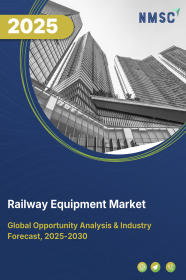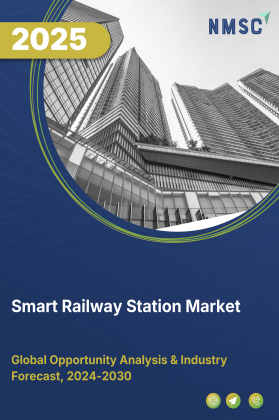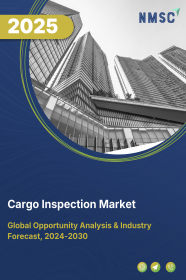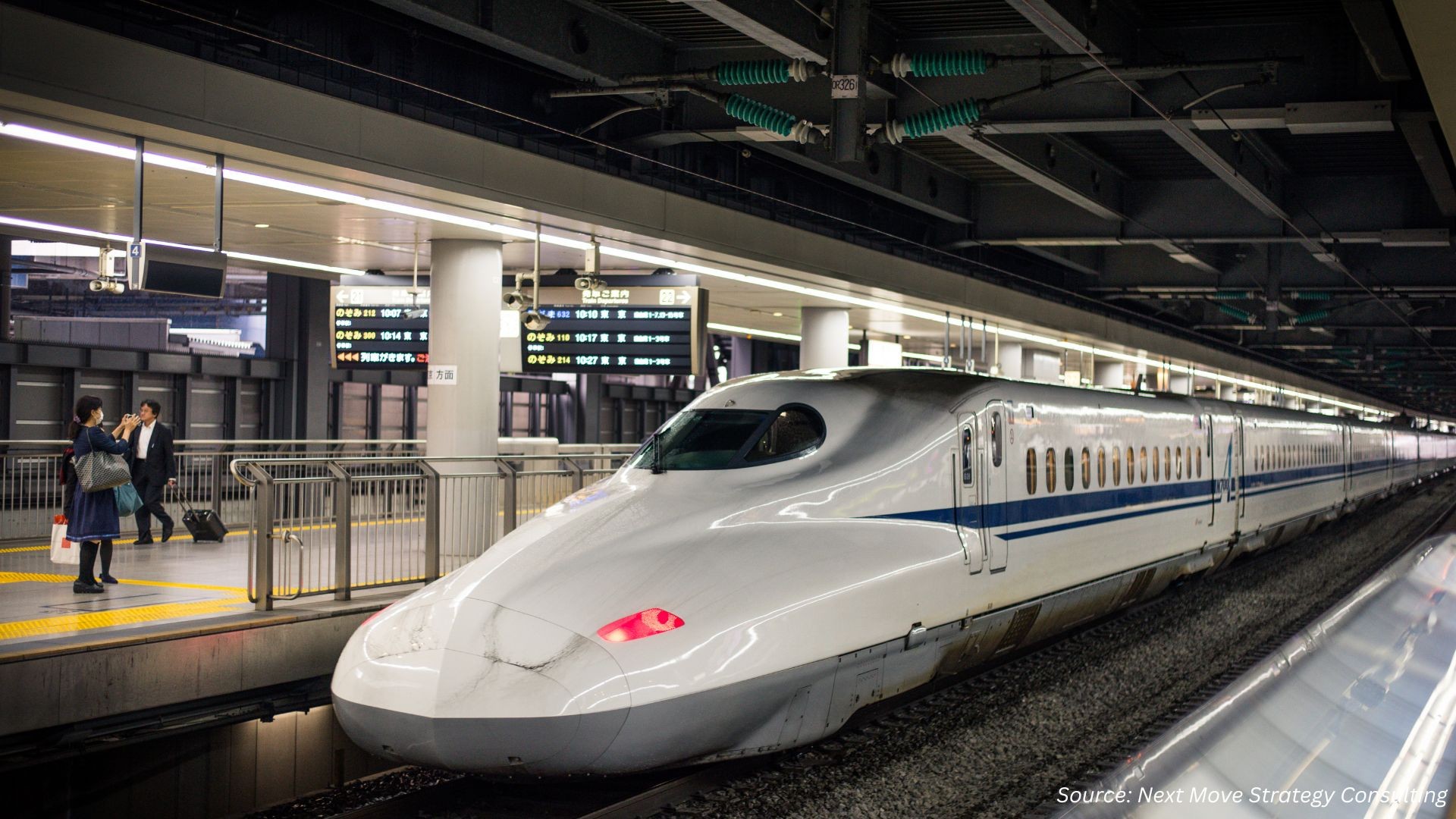
Railway Equipment Market by Rolling Stock (Locomotives, Passenger Coaches, and Others), by Infrastructure Equipment (Track Components, and Others), by Maintenance & Construction Machinery (Track Maintenance, and Others), by Components & Sub‑assemblies (Propulsion Systems, and Others), by Digital & Smart Solutions (Automation & Control (PTC, ATP), and Others), by Services & Aftermarket (Consultancy & Integration, and others) - Global Opportunity Analysis and Industry Forecast 2025-2030.
Railway Equipment market Overview
The global Railway Equipment Market size was valued at USD 107.11 billion in 2024 and is predicted to reach USD 134.04 billion by 2030 with a CAGR of 3.8% from 2025-2030.
The factors such as growing urbanization, increasing investment of railway infrastructure along with the expansion of tourism industry drives the market growth. However, high initial investments required for implementing advanced technologies in railway management systems hinders the market growth. On the contrary, introduction of smart technologies such as IoT and AI create future opportunities for the growth of the market. Moreover, top companies such as Cisco Systems Inc. and Hyundai Rotem are taking various initiatives such as partnerships to maintain their dominance in the railway equipment industry. As the market matures, growing demand for railway equipment is foreseen to instigate further growth.
Growing Urbanization Fuels the Market Growth
Rising urbanization drives the railway equipment market expansion due to rising demand of transportation infrastructure and the need for efficient transportation solutions for the population staying in urban areas. Railways provide an efficient and safe means of mass transit to address these issues.
According to a recent report by the World Bank Group, overall urban population across the globe increased to 4.61 billion in 2023 from 4.54 billion in 2022. Thereby the increase in the urban populations fuels the growth of railway equipment industry boosting the market growth.
Increasing Investment in Railway Infrastructure Drives Market Growth
Rise in investment in rail infrastructure is driving the market spurred by the demand for efficient, sustainable and reliable transportation system. The governments, along with the private sector investors are constantly recognizing the significance of upgrading and extending the rail transport to improve inter-connectivity, decongest cities and curb carbon emissions.
According to a latest report by the Federal Railroad Administration, the U.S. Department of Transportation Federal Railroad Administration announced more than USD 2.40 billion in Bipartisan Infrastructure Law funding for 122 rail improvement projects in 41 states.
Also, according to a latest report by India Brand Equity Foundation, the Indian Railways committed to invest an amount of USD 83.91 billion over the next decade to lay 50,000 kilometres of new tracks. Such increase in investment in the infrastructure of railways is anticipated to drive the demand for railway equipment fuelling the market growth.
Expansion of Travel and Tourism Industry Drives the Market Growth
As the travel and tourism market expands, there is increased demand for smart, efficient, and scalable transport systems. Railways are crucially fulfilling this demand, driving market expansion through improved operational efficiency, enhanced customer experience, and sustainable support.
As per the latest report from the World Travel & Tourism Council, tourism sector accounted for 9.1% of the global GDP, an 23.2% increase over 2022. So, the expansion of tourism industry is anticipated to drive the demand for railway equipment fuelling the market growth.
High Initial Investments Hinders the Market Growth
High initial investments in of installing advanced equipment in railway technologies hinders the growth of the market. The majority of railway operators, especially in the developing world, may not be able to meet the cost of upgrading infrastructure and software, thereby limiting the railway equipment market growth.
Introduction of Smart Technologies Create Future Opportunities
The introduction of smart technologies such as IoT, AI and machine learning creates future opportunities for the growth of the market by allowing predictive maintenance, and effective resource allocation, enhancing operational efficiency as well as passenger experience.
Market Segmentation and Scope of Study
The global railway equipment market report is segmented on the basis of technology, type, and region. Based on technology, the market is classified into conventional rail, high-speed rail, and urban transit. Based on product type, the market is segmented into locomotives, passenger coaches, freight card, and others. Locomotives can be further bifurcated into diesel locomotives, and electric locomotives. Passenger Coaches can be further segmented into conventional passenger coaches, high-speed conventional coaches, DMUs (Diesel Multiple Units), and EMUs (Electric Multiple Units). Geographical breakdown and analysis of each of the aforesaid classifications include regions comprising of North America, Europe, Asia-Pacific, and RoW.
Geographical Analysis
Europe region dominates the railway equipment market share. This is primarily due to strong infrastructure, well established railway networks, and increasing railway passengers in the region. As per a recent report published by Office of Rail and Road UK, there were 1.70 billion passenger rail journeys in the 12 months leading up to September 2024, a 12% increase from the previous year in UK. So, the increasing use of railway transport fuels the demand of better infrastructure and advanced equipment in railways thereby driving the market growth.
Moreover, rising tourism industry in across the countries of European Union drives the demand of railway equipment. Train travel tends to be the major choice of transportation because it is convenient, environmentally friendly, and holds extensive coverage.
According to a report published by the Eurostat in January 2025, in the first 10 months of 2024, 2.70 billion nights were spent in tourist accommodation in the EU. This marked an increase of 42 million nights compared with the same period in 2023. Such increase in tourism in the region fuels the demand of better infrastructure in railways thereby boosting the railway equipment industry growth.
On the other hand, Asia-Pacific is the fastest growing region of the railway equipment industry this is due to the urbanization in the region that necessities the need for public transport, such as rail, increased tremendously. China's wide urbanization and expanding metropolitan regions, such as Beijing, Shanghai, and Shenzhen, provide a compelling need for sophisticated transportation infrastructure to handle millions of passengers a day.
According to a report published by Observer Research Foundation, in August 2023, in the period between 2025 to 2050, an urban increment of 1.70 billion people is projected globally, with China making a contribution of 186 million. Thus, increase in urbanization in China is poised to drive the demand of better transportation infrastructures thereby driving the growth of the market.
Moreover, rising government efforts in the region to the railway industry enhances the growth of the market in the region. To cope up with the growing demand for safe and efficient travel, the Indian government gave high priority to the development and improvement of the country's railway system.
For example, the government of India launched Rail Drishti in the year 2019, that is still applicable to analyse and monitor the key parameters of Indian Railways with an aim to meet the objectives of transparency and accountability. Such government initiatives drive the railway equipment market demand, fueling its growth.
Competitive Landscape
The railway equipment industry includes several key market players such as CRRC Corporation Limited, Alstom SA, Siemens Mobility GmbH, Wabtec Corporation, Hitachi Rail Limited, Knorr-Bremse AG, Construcciones Y Auxiliar De Ferrocarriles, S.A. (CAF), Stadler Rail AG, Thales SA, Kawasaki Heavy Industries, Ltd., Hyundai Rotem Company, ABB Ltd., Vossloh AG, Talgo SA, Progress Rail Services Corporation, Mitsubishi Electric Corporation, Toshiba Corporation, Voestalpine AG, China Railway Signal & Communication Corporation Ltd. (CRSC), Transmashholding OJSC, Komatsu Ltd., Plasser And Theurer GmbH, Harsco Rail Division (Harsco Corp.), Loram Maintenance, Manitowoc (Grove Cranes) and others. These market players are adopting various strategies such as acquisition and collaboration to maintain their dominance in the railway equipment industry.
For instance, in April 2025, CRRC Corporation LimitedHeld its annual results briefing in Hong Kong. Reported significant year-on-year growth: rail equipment revenue rose 12.5%, while new industry revenue increased 7.1%. Total new orders reached approximately RMB 322.2 billion, including RMB 47.2 billion in international orders. Unveiled new innovations such as the CR450 EMU prototype, hydrogen-powered urban train trial, and a 20 MW floating offshore wind turbine.
Also, in October 2024, Wabtec Corporation, Secured a US$405 million contract to supply ES44ACi Evolution Series locomotives to Kazakhstan Temir Zholy, enhancing freight operations along the Trans-Caspian route.
Key Benefits
-
The report provides quantitative analysis and estimations of the railway equipment industry from 2025 to 2030, which assists in identifying the prevailing market opportunities.
-
The study comprises a deep-dive analysis of the current and future railway equipment market trends to depict prevalent investment pockets in the industry.
-
Information related to key drivers, restraints, and opportunities and their impact on the railway equipment industry is provided in the report.
-
Competitive analysis of the key players, along with their market share is provided in the report.
-
Value chain analysis in the market study provides a clear picture of roles of stakeholders.
Railway Equipment Market Key Segments
By Rolling Stock
-
Locomotives
-
Diesel
-
Electric
-
Hybrid
-
Hydrogen
-
-
Passenger Coaches
-
Conventional Coaches
-
High-Speed Trains
-
Diesel Multiple Units (DMUs)
-
Electric Multiple Units (EMUs)
-
-
Freight Vehicles
-
Wagons
-
Tankers
-
Intermodal
-
-
Urban Transit Vehicles
-
Metro
-
Light Rail
-
Trams
-
By Infrastructure Equipment
-
Track Components
-
Rail
-
Sleepers
-
Fasteners
-
-
Electrification Systems
-
Catenary
-
Substations
-
-
Signaling & Control
-
CBTC (Communications-Based Train Control)
-
ETCS (European Train Control System)
-
Traffic Management Systems
-
-
Stations & Fixed Assets
-
Platforms
-
Security Equipment
-
By Maintenance & Construction Machinery
-
Track Maintenance
-
Tamping Machines
-
Ballast Cleaners
-
-
Rail Handling
-
Welding Machines
-
Drilling Rigs
-
-
Diagnostic & Inspection
-
Geometry Cars
-
Drones
-
-
Earthmoving Equipment
-
Excavators
-
Loaders
-
Sidebooms
-
-
Specialized Rail Vehicles
-
Hi-Rail Cranes
-
LSTs
-
By Components & Sub‑assemblies
-
Propulsion Systems
-
Bogies
-
Traction Motors
-
-
Braking & Coupling Systems
-
Interiors & Comfort
-
Seats
-
HVAC
-
By Digital & Smart Solutions
-
Automation & Control (PTC, ATP)
-
IoT & Analytics
-
Energy Management
-
Cybersecurity
By Services & Aftermarket
-
Consultancy & Integration
-
Leasing & Financing
-
Maintenance & Spare Parts
By Region
-
North America
-
The U.S.
-
Canada
-
Mexico
-
-
Europe
-
The UK
-
Germany
-
France
-
Italy
-
Spain
-
Denmark
-
Netherlands
-
Finland
-
Sweden
-
Norway
-
Russia
-
Rest of Europe
-
-
Asia-Pacific
-
China
-
Japan
-
India
-
South Korea
-
Australia
-
Indonesia
-
Singapore
-
Taiwan
-
Thailand
-
Rest of Asia-Pacific
-
-
RoW
-
Latin America
-
Middle East
-
Africa
-
Key Players
-
CRRC Corporation Limited
-
Alstom SA
-
Siemens Mobility GmbH
-
Wabtec Corporation
-
Hitachi Rail Limited
-
Knorr-Bremse AG
-
Construcciones Y Auxiliar De Ferrocarriles, S.A. (CAF)
-
Stadler Rail AG
-
Thales SA
-
Kawasaki Heavy Industries, Ltd.
-
Hyundai Rotem Company
-
ABB Ltd.
-
Vossloh AG
-
Talgo SA
-
Progress Rail Services Corporation
-
Mitsubishi Electric Corporation
-
Toshiba Corporation
-
Voestalpine AG
-
China Railway Signal & Communication Corporation Ltd. (CRSC)
-
Transmashholding OJSC
-
Komatsu Ltd.
-
Plasser And Theurer GmbH
-
Harsco Rail Division (Harsco Corp.)
-
Loram Maintenance
-
Manitowoc (Grove Cranes)
REPORT SCOPE AND SEGMENTATION:
|
Parameters |
Details |
|
Market Size in 2024 |
USD 107.11 Billion |
|
Revenue Forecast in 2030 |
USD 134.04 Billion |
|
Growth Rate |
3.8% from 2025 to 2030 |
|
Analysis Period |
2024–2030 |
|
Base Year Considered |
2024 |
|
Forecast Period |
2025–2030 |
|
Market Size Estimation |
Billion (USD) |
|
Growth Factors |
|
|
Countries Covered |
28 |
|
Companies Profiled |
25 |
|
Market Share |
Available for 10 companies |
|
Customization Scope |
Free customization (equivalent to up to 80 working hours of analysts) after purchase. Addition or alteration to country, regional, and segment scope. |
|
Pricing and Purchase Options |
Avail customized purchase options to meet your exact research needs. |




















 Speak to Our Analyst
Speak to Our Analyst

























